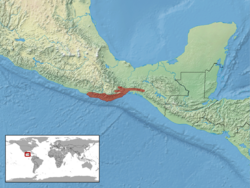Biology:Porthidium dunni
| Porthidium dunni | |
|---|---|

| |
| Scientific classification | |
| Domain: | Eukaryota |
| Kingdom: | Animalia |
| Phylum: | Chordata |
| Class: | Reptilia |
| Order: | Squamata |
| Suborder: | Serpentes |
| Family: | Viperidae |
| Genus: | Porthidium |
| Species: | P. dunni
|
| Binomial name | |
| Porthidium dunni (Hartweg & Oliver, 1938)
| |

| |
| Synonyms[2] | |
| |
- Common names: Dunn's hognosed pitviper.[3]
Porthidium dunni is a species of venomous pitviper in the family Viperidae. The species is endemic to Mexico. There are no recognized subspecies.[4]
Etymology
The specific name, dunni, is in honor of United States of America herpetologist Emmett Reid Dunn[5] "in appreciation of his work on American snake fauna".[6]
Description
Adults of P. dunni are usually 30–40 cm (11 3⁄4–15 3⁄4 in) in total length (including tail), with a maximum of 57 cm (22 1⁄2 in). A moderately stout and terrestrial species, the tip of the snout is moderately elevated.[3]
Geographic range
P. dunni is found in southern Mexico in the Pacific lowlands of Oaxaca and western Chiapas.[7]
The type locality given is "the immediate vicinity of the village of Tehuantepec" [Oaxaca, Mexico].[2]
Habitat
The preferred natural habitat of P. dunni is forest.[1]
Reproduction
P. dunni is ovoviviparous.[7]
Conservation status
The species P. dunni is classified as Least Concern (LC) on the IUCN Red List of Threatened Species (v3.1, 2007).[1] Species are listed as such due to their wide distribution, presumed large population, or because it is unlikely to be declining fast enough to qualify for listing in a more threatened category. The population trend is stable. Year assessed: 2007.[8]
References
- ↑ 1.0 1.1 1.2 Muñoz-Alonso A (2007). "Porthidium dunni ". The IUCN Red List of Threatened Species 2007: https://dx.doi.org/10.1305/IUCN.UK.2007-RLTS.T64342A12772353.en. Accessed on 09 October 2022.
- ↑ 2.0 2.1 McDiarmid RW, Campbell JA, Touré TA (1999). Snake Species of the World: A Taxonomic and Geographic Reference, Volume 1. Washington, District of Columbia: Herpetologists' League. 511 pp. ISBN:1-893777-00-6 (series). ISBN:1-893777-01-4 (volume).
- ↑ 3.0 3.1 Campbell JA, Lamar WW (2004). The Venomous Reptiles of the Western Hemisphere. 2 volumes. Ithaca and London: Comstock Publishing Associates. 870 pp. 1,500 plates. ISBN:0-8014-4141-2.
- ↑ "Porthidium dunni". Integrated Taxonomic Information System. https://www.itis.gov/servlet/SingleRpt/SingleRpt?search_topic=TSN&search_value=585988.
- ↑ Beolens, Bo; Watkins, Michael; Grayson, Michael (2011). The Eponym Dictionary of Reptiles. Baltimore: Johns Hopkins University Press. xiii + 296 pp. ISBN:978-1-4214-0135-5. (Porthidium dunni, p. 77).
- ↑ Hartweg & Oliver (1938), pp. 5–6.
- ↑ 7.0 7.1 Species Porthidium dunni at The Reptile Database www.reptile-database.org.
- ↑ 2001 Categories & Criteria (version 3.1) at the IUCN Red List. Accessed 15 September 2007.
Further reading
- Hartweg N, Oliver JA (1938). "A Contribution to the Herpetology of the Isthmus of Tehuantepec: III. Three New Snakes from the Pacific Slope". Occasional Papers of the Museum of Zoology, University of Michigan (390): 1-8 + Plate I. (Trimeresurus dunni, new species, pages 6–7 + Plate I, Figures B & D).
- Heimes P (2016). Snakes of Mexico: Herpetofauna Mexicana Vol. I. Frankfurt am Main, Germany: Chimaira. 572 pp. ISBN:978-3899731002.
- Mata-Silva V, Johnson JD, Wilson LD, García-Padilla E (2015). "The herpetofauna of Oaxaca, Mexico: composition, physiographic distribution, and conservation status". Mesoamerican Herpetology 2 (1): 6–62. (in English, with an abstract in Spanish).
- Mata-Silva V, Rocha A, DeSantis DL, García-Padilla E, Wilson LD (2016). "Porthidium dunni (Hartweg and Oliver, 1938). Arboreality". Mesoamerican Herpetology 3 (1): 156–157.
Wikidata ☰ Q3019076 entry
 |


